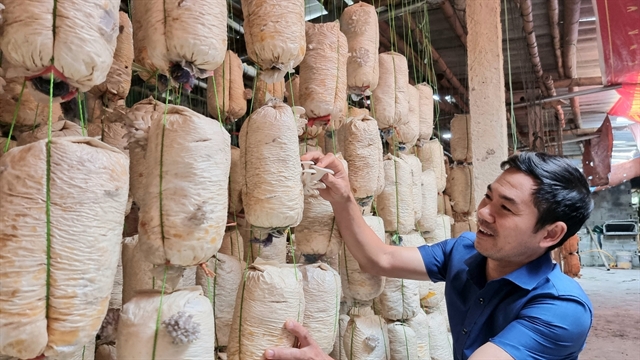 Society
Society

Lê Văn Thành, chairman of the Farmers’ Association of Thế Thọ Commune, has developed a clean mushroom-growing model, bringing in high incomes for local farmers in the northern province of Thanh Hoá’s Triệu Sơn District.

|
| Lê Văn Thành takes care of his mushrooms in Thế Thọ Commune, the northern province of Thanh Hoá’s Triệu Sơn District.— Photo danviet.vn |
HÀ NỘI — Lê Văn Thành, chairman of the Farmers’ Association of Thế Thọ Commune, has developed a clean mushroom-growing model, bringing in high incomes for local farmers in the northern province of Thanh Hoá’s Triệu Sơn District.
His farm sells 70-120 kilos of mushroom daily. The price of oyster mushrooms is about VNĐ25,000-27,000 (US$1.1-1.2) per kilo and VNĐ120,000-150,000 ($5.3-6.6) per kilo of wood ear mushroom.
Through his mushrooms, Thành could earn profit of VNĐ200 million ($8,800) per year.
Thành said in the 2010s, during his work as the chairman of the association, he visited many agricultural models in other localities.
He started to think of growing mushrooms when he realised that the income was higher than growing rice, he said.
In 2015, Thành decided to build a home-grown farm after he learned a lot about growing mushrooms.
After he piloted the mushrooms in a small area and saw positive results, Thành expanded the area to 500 sq.m.
He bought shelves and other equipment to grow the mushrooms in a clean and safe way, he said.
Thành said he took advantage of locally available raw materials, such as sawdust and corn bran, to produce mushroom embryo bags, therefore, the production cost was significantly reduced.
However, the cultivation of mushrooms also faced many difficulties due to weather and diseases, especially flies and mosquitoes that laid eggs and destroyed the embryos.
"Mushrooms are very sensitive to environmental factors such as temperature, humidity, light and pests. Therefore, producers need to follow the correct technical process so that mushrooms could grow well," he said.
Thành said different techniques were needed to grow and take care of each type of mushroom, Dân Việt (Vietnamese People) online newspaper reported.
However, the most important steps to produce high-quality mushrooms were how to select the good quality mushroom spores and incubate the raw materials to make mushroom embryos, he said.
The mushroom embryos must be of good quality and the materials to grow mushrooms must be clean in order to result in high-quality produce, he said.
For oyster mushrooms, the raw materials of sawdust and corn bran must be ground, mixed well, packed in plastic bags and sterilised before growing the mushrooms, he said.
He also said it was necessary to incubate the mushroom spores for 20-30 days and then use a knife to make six to nine incisions around the bag, the size of each incision was about 2-3cm in width and 4-5cm in depth.
The mushrooms began to grow from the incisions after 7-10 days. When the mushroom cap reached a diameter of 3-4 cm, it would be time to harvest, he said.
"You have to be careful when picking the mushrooms to not affect the yield and quality," he said.
Thành always watered the mushrooms with clean water and often clean the farm, he said.
Thành now mainly provides wood ear mushrooms and oyster mushrooms for the local market, sometimes he also serves customers in Hà Nội.
His mushroom farm has created jobs for five seasonal workers with an average salary of VNĐ120,000 ($5.3) per day.
Thành said he wanted to multiply his model in the commune to raise incomes for local residents.
“I’m willing to instruct people, who want to follow the model of growing mushrooms,” he said.
Nhữ Mai Thoả, deputy chairman of the Farmers' Association of the district, said Thành was not only very responsible for his assigned works as a head of the commune-level Farmers’ Association but also a good farmer of the district.
Thoả also said Thành’s model of growing mushrooms was effective in bringing high incomes for the grower.
Thus, the district-level Farmers’ Association planned to multiply the model across the whole district in the future to create more jobs and improve income for local farmers, Thoả said. — VNS




